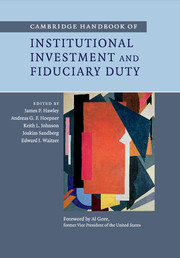Book contents
- Frontmatter
- Contents
- List of figures
- List of tables
- List of contributors
- Foreword
- 1 Introduction
- Part I Fiduciary duty: a global outlook
- Part II Fiduciary duty and the landscape of institutional investment
- 8 The philanthropic fiduciary: challenges for nonprofits, foundations and endowments
- 9 Paradigm lost: employment-based defined benefit plans and the current understanding of fiduciary duty
- 10 Economically targeted investing: changing of the guard
- 11 Institutional investment in the European Union Emissions Trading Scheme
- 12 Have institutional fiduciaries improved securities class actions? A review of the empirical literature on the PSLRA’s lead plaintiff provision
- 13 The future of fiduciary obligation for institutional investors
- Part III Challenging conventional wisdom on fiduciary duty
- Part IV Towards a broader interpretation of fiduciary duty
- Part V Beneficiaries’ roles and viewpoints
- Part VI Fiduciary duty and governance
- Index
- References
11 - Institutional investment in the European Union Emissions Trading Scheme
Published online by Cambridge University Press: 05 April 2014
- Frontmatter
- Contents
- List of figures
- List of tables
- List of contributors
- Foreword
- 1 Introduction
- Part I Fiduciary duty: a global outlook
- Part II Fiduciary duty and the landscape of institutional investment
- 8 The philanthropic fiduciary: challenges for nonprofits, foundations and endowments
- 9 Paradigm lost: employment-based defined benefit plans and the current understanding of fiduciary duty
- 10 Economically targeted investing: changing of the guard
- 11 Institutional investment in the European Union Emissions Trading Scheme
- 12 Have institutional fiduciaries improved securities class actions? A review of the empirical literature on the PSLRA’s lead plaintiff provision
- 13 The future of fiduciary obligation for institutional investors
- Part III Challenging conventional wisdom on fiduciary duty
- Part IV Towards a broader interpretation of fiduciary duty
- Part V Beneficiaries’ roles and viewpoints
- Part VI Fiduciary duty and governance
- Index
- References
Summary
Introduction
This chapter explores the role of institutional investment in the most high-profile contemporary environmental market – the European Union’s Emissions Trading Scheme (EU ETS). Before doing so, it is important to place carbon trading and the EU ETS in its broader historical context in terms of the evolution of institutional investment, fiduciary duty, environmental markets and environmental investment.
Drucker (1991: 106) notes that the establishment of the first modern pension fund in the 1950s heralded a transition in which institutional investors became the “dominant owners and lenders” and represented one of the “most startling power shifts in economic history.” This transformation led to the emergence of “fiduciary capitalism,” where institutional investors became the largest owners of corporate equity (Hawley and Williams 2000a). Their ever-expanding size and relentless search for “alpha” and diversification benefits have meant that these “universal owners” have diversified long-term investments across asset classes, sectors and geographies (Hawley and Williams 2000a, 2007). Due to these characteristics, universal owners have been aware for some time that their interests are tied to those of the economy and society at large and are therefore unable to avoid externalities, in particular environmental externalities (Hawley and Williams 2000a). The impact of environmental externalities such as pollution, waste or changes in the use of resources can cause institutional investors to suffer reduced cash flows from investments, increase environmental costs and augment uncertainty in capital markets. Investors with exposure to net losses from portfolios with externalities have an incentive to take action and make investments to hedge the environmental risk (Hawley and Williams 2000b).
- Type
- Chapter
- Information
- Publisher: Cambridge University PressPrint publication year: 2014



